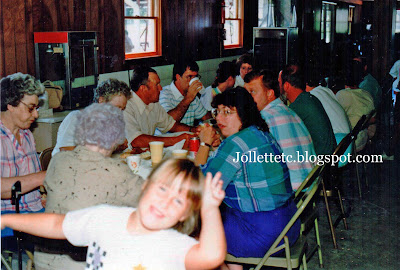Sepia Saturday challenges bloggers to share family
history through old photographs.
This week’s Sepia Saturday photo has made me imagine what
my early ancestors might have looked like sitting at some home-crafted table in
their roughly-hewn log house in the wilderness of frontier America. My children
and grand-baboos will not have to work as hard to imagine it as I do because
they have an ancestral home to look to.
This is the John T. Mathias Homestead in where else but
Mathias, West Virginia. This historic home was built by my husband Barry’s 4X
great-grandfather in 1797 and remained in the Mathias family for over 165 years
before the last owner deeded it to the Mathias Civic Center Association in
1974. Four years later it was listed on the National Register of Historic
Places. The Mathias homestead even has its own Wikipedia page. Yeah, we’re
pretty famous - in a small town.
John Tobias Mathias (who doesn’t love a rhyming name?) was
among the earliest settlers in the area. Like many of our German ancestors, his
family emigrated from Alsace-Lorraine to escape religious persecution. His
family first settled around Philadelphia and then moved inland into Lancaster
County. From there they moved to Frederick County, Maryland and then on to the
Shenandoah Valley of Virginia. Their last stop was the Lost River Valley in
Hardy County. At the time it was a frontier county of Virginia; since the Civil
War, it is in West Virginia.
 |
| courtesy Justin A. Wilcox 2014 Wikimedia Commons CC by SA 4.0 |
John T. acquired the land in 1791. The house he built had
four rooms, an attic loft, sturdy interior stairs, a good number of windows, a
double porch and fireplace on both floors. It was considered quite substantial
for its time. However, the next generation found the house to be too small and
so SOMEONE - probably his son John T. Jr. or grandson - built an addition in
1825.
 |
| Back view courtesy Justin A. Wilcox 2014 Wikimedia Commons CC by SA 4.0 |
 |
| End view courtesy Justin A. Wilcox 2014 Wikimedia Commons CC by SA 4.0 |
The Mathias house was considered rather grand for its time, especially for poor farmers living in the Lost River Valley. Its location on the main road made it a natural stop for travelers seeking a safe place to rest overnight. Not surprisingly the Mathias family found themselves hosting some famous people and events.
 |
| Lee Sulphur Springs Lost River State Park, Mathias, WV |
One such guest was General Henry “Light Horse Harry” Lee
of Revolutionary War fame. Supposedly he made the Mathias house his headquarters
prior to purchasing his own tract of land just up the road in what is now Lost
River State Park. In an earlier version of the park, it had been known as
Howard’s Lick Resort, a popular vacation spot boasting the medicinal benefits
of Lee Sulphur Springs. And just so you know, I’ve stood at those springs at
many a Mathias reunion. Pee-yoo!
The Mathias homestead was also the site for some county
court meetings. During the Civil War, Hardy County was divided over whether to
support the Union or the Confederacy. From Barry’s ancestors’ Civil War
records, it appears the folks in and around Mathias supported the South. Nearly
a year after West Virginia was formed, a VIRGINIA County Court meeting was
conducted at the Mathias house on May 2, 1864. Southern sentiment was still running deep, it seems.
The house likely passed from John T. in 1806 to his son
John T. Jr who passed it to his son John B. in 1866. From John B. the house
passed to John Thomas who in 1891 passed the house to Philip Seymour Mathias, a
great-great grandson of John T. Mathias.
Philip’s family was the last to occupy the home. They are
pictured here probably about 1905 judging by the assumed ages of the youngest children
and the absence of two who were not yet born. The house had been modernized
with clapboard siding and whitewashed.
The last resident of the home place was Sadie Caldwell
Mathias, Philip's widow. After her
death in 1969, the house sat empty until sons Virgil and Wendell Mathias sold
it to the Mathias Civic Center Association in 1974. The association also
purchased additional property for the construction of its civic center.
For many years, the Mathias reunion was held at Lost
River State Park on Father’s Day. One year failure to reserve a spot prompted
the family to gather at the Mathias Community Center instead.
 |
| 1989 - Descendants of John T. Mathias around the table |
 |
| 1989 - Making room for all the food |
Looking at the 1989 reunion pictures, I am amused by the
two-tone wall - just the opposite of the walls in the prompt photo.
Everyone is invited to the table at Sepia Saturday.
Wendy
© 2018, Wendy Mathias. All rights reserved.












